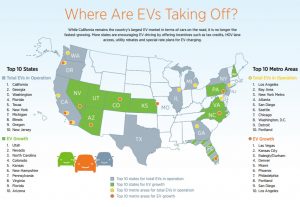 ChargePoint and McKinsey & Co. have put out studies in the past week offering an interesting look at the state of plug-in electrified vehicles and the charging infrastructure in the U.S. and abroad.
ChargePoint and McKinsey & Co. have put out studies in the past week offering an interesting look at the state of plug-in electrified vehicles and the charging infrastructure in the U.S. and abroad.
California continues to be the leading U.S. market for registered PEVs on its roads, with about half of all battery electric and plug-in hybrid electric vehicle sales taking place there, according to the ChargePoint study. Georgia, known for its generous PEV incentives, was No. 2 on list. Washington was No. 3, but a surprising ranking was Oregon coming in at No. 9 when it’s been very competitive with Washington and California as part of the PEV charging highway infrastructure. Florida and Texas came in at Nos. 4 and 5 on list. Four other strong markets made the list with New York at 6, Michigan at 7, Illinois at 8, and New Jersey at No. 10.
As for the PEV market growth, another surprising state made the list, with Utah at No. 1, followed by Nevada, North Carolina, Colorado, Kansas, New Hampshire, Pennsylvania, Virginia, Florida, and Arizona. ChargePoint compiled the report’s findings with date provided by IHS Market through the third quarter of 2016. Growth figures for these top 10 states represent growth over Q3 2015.
As for cities seeing the strongest presence based on PEVs in operation, California had three of the cities, with Los Angeles at No. 1 over San Francisco at No. 2 (another surprise), and San Diego at No. 5. New York came in at 3, Atlanta at 4, Seattle at 6, Chicago at 7, Washington, D.C. at 8, Detroit at 9, and Portland, Ore., at 10.
As for PEV growth cities, several of them are considered to be significant business centers for conferences and meetings. Charging stations are being installed at airports, hotels, retail stories, and workplaces, supporting regions that have economic growth and interest in PEVs. Las Vegas was the No. 1 city in PEV growth in the past year, followed by Kansas City, Raleigh/Durham, Denver, Miami, Phoenix, Philadelphia, Portland, San Diego, and Los Angeles.
The charging company also reported on the Top 5 PEVs sold in the U.S. last year. The Tesla Model S was No. 1, followed by the Chevy Volt, Ford Fusion Energi plug-in hybrid, Tesla Model X, and the Nissan Leaf. According to Baum and Associates and InsideEVs.com, it split at 53% battery electric and 47% and for plug-in hybrids.
Gasoline prices were an interesting trend to see studied in the report. PEV sales used to be very tied to gas prices, but for over two years these prices have stayed down in and stable in the U.S. Consumers had been very interested in saving money. Now the sales chart shows that PEV sales have gone up as gas prices have stayed down. Consumers are interested in PEVs for reasons beyond gas savings, according to the study.
McKinsey on seeing breakthroughs in PEV sales
A new study by global consulting firm McKinsey & Co. looked at where consumers in key markets, and automakers, see adoption of PEVs going in the next few years. Electrifying insights: How automakers can drive electrified vehicle sales and profitability digs into consumer tastes and interests, and where auto manufacturing is heading in response.
Two studies were conducted with consumers interested in PEVs and consumers who own them. About 3,500 people were surveyed in the U.S., Germany, and Norway; and a second study was done with about 3,500 people in China interested in, and owning, PEVs.
The core issue for automakers is being overwhelmed by new technologies to invest in to meet emissions standards around the world, and to prepare for growing interest in PEVs of all types. As automakers invest a great deal of capital in fuel efficient technologies like start-stop, turbocharging, and lightweighting, investing sufficiently in battery packs and other needed components loses some of its value. That’s been intensified by growing interest in connected, autonomous vehicle systems.
Consumers are becoming more interested, and have a few factors they’re questioning and considering:
- About half the surveyed consumers in the U.S. and Germany say they understand how PEVs work. Between 30-and-45 percent of vehicle buyers in the U.S. and Germany, respectively, have considered a PEV purchase. Strong demand is being seen in Norway and China, where incentives have been ample and have been seen in sales results.
- The study sees reaching the other half of consumers in these countries to be an important opportunity, but the message will need to be revised.
- Making batteries with more capacity will be a big part of getting past limited sales, and getting their cost down for manufacturers is part of it. The study says it’s costing automakers about $13,600 for the battery pack with 60 kWh of power. There are other costs that go into it such as the electric motor, high-voltage wiring, on-board chargers, and inverters.
- There’s also keeping it all within economies of scale. Adding a new PEV and building it at decent numbers means a lot of capital being place in opening up a new factory, or opening lanes at an existing plant, tooling, R&D and getting the product to market through dealer networks retail stories, and launching marketing campaigns.
- Premium luxury cars by Tesla Motors and a few competitors are taking a lot of the sales, but there’s been a bit of a void for consumers interested in a wide selection of small cars, SUVs, and crossovers. McKinsey sees this as one of the opportunities, especially for consumers living in cities looking for more options and spending less on their vehicles.
- Automakers and dealers would be smart to sell PEVs from a different perspective. Instead of purchase price and lease deals, focusing on total cost of ownership (TCO) would be a better way to go. For example, PEV owners are typically paying about 20% to 40% less on maintenance costs over a five-year period compared to vehicles with internal-combustion engines.
- Growth in ride-hailing, carsharing, and peer-to-peer car rental are expected to have strong PEV market potential, according to McKinsey. The study found that more than 30 percent of consumers surveyed would prefer a PEV model over an ICE when using ride-hailing services such as Uber and Lyft; and about 35 percent would pay a premium to ride in a PEV.
- Carsharing provides an opportunity to get consumers to try out a PEV through promotional offers. Companies such as Maven, Zipcar, and Car2go could tap into this market potential.
- Another service to provide could be P2P (peer-to-peer) car rental. Consumers who own a PEV could make money renting out their car when it’s not being used.

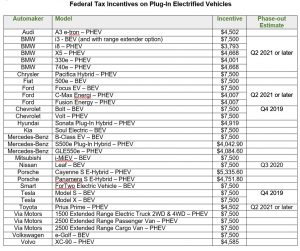 Each automaker’s qualifying PEV receives a federal credit until the 200,000th plug-in vehicle is registered inside the U.S.; at that point, tax credits are reduced and then phased-out over an allotted time period. Once the 200K mark is reached, the full tax credit continues through the end of that quarter and until the end of the next one. Credits on a $7,500 tax credit will drop to $3,750 for the next six months, and then to $1,875 for the next six months before going away. The chart below shows the phase-out quarter being the estimated time period when the tax incentive disappears.
Each automaker’s qualifying PEV receives a federal credit until the 200,000th plug-in vehicle is registered inside the U.S.; at that point, tax credits are reduced and then phased-out over an allotted time period. Once the 200K mark is reached, the full tax credit continues through the end of that quarter and until the end of the next one. Credits on a $7,500 tax credit will drop to $3,750 for the next six months, and then to $1,875 for the next six months before going away. The chart below shows the phase-out quarter being the estimated time period when the tax incentive disappears.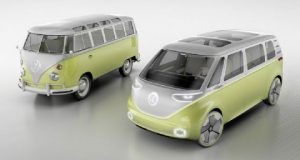 Detroit auto show: The North American International Auto Show has not been dominated by certain vehicle types, such as pickups and SUVs might have done in the past. Plug-in electrified vehicles have played their part, along with futuristic concept vehicles and mobility services. Back-to-back with the influential CES 2017 show in Las Vegas, the two car shows have had a few things in common. Volkswagen’s I.D. Buzz has taken a lot of attention. The electric microbus of the future is built on the MEB platform and may be able to travel 270 miles once fully charged. It offers maximum space utilization with all-wheel drive, electric motors at the front and rear axles, a fully autonomous driving mode (“I.D. Pilot”), and a new generation of display elements and controls…. The all-new Chevy Bolt electric car continues to win big awards, taking the North American Car of the Year award. The Chrysler Pacifica minivan was named North American Utility of the Year, the first time the award has been given out, and it also comes in a plug-in hybrid variation….. BMW showed its new 530 iPerformance plug-in hybrid. At 248 hp, it will go to 60 mph in about 5.9 seconds. It will also deliver up to 14 miles in all-electric mode, earning an EPA-rated 64 MPGe. The rear-wheel drive version will start at $51,400 while the all-wheel drive xDrive version will begin at $53,700…… Ford presented its vision for the “City of Tomorrow.” It looks at how near-term mobility advancements – including autonomous and electric vehicles, ride-sharing, ride-hailing, and connected vehicles – interact with urban infrastructure and create a transportation ecosystem to deal with challenges such as gridlock and air pollution. Ford’s City Solutions team has been working with cities around the world to propose, pilot, and develop mobility solutions. The team also is beginning to collaborate with Bloomberg Philanthropies and its global coalition of mayors…… Toyota rolled out a redesigned 2018 Camry with more interior space, advancements in its drive system, and a hybrid version that gets Prius-like fuel economy……… Waymo CEO John Krafcik announced that the former Google self-driving car division has been able to drop the cost of its Lidar sensors from about $75,000 per vehicle to about $7,500, which will help lower the cost of autonomous vehicle technologies for interested automaker partners. These new Lidar systems will be installed soon in 100 self-driving Chrysler Pacifica minivans that Waymo acquired from Fiat Chrysler Automobiles…… Audi unveiled the all-new Q8 SUV plug-in hybrid that will be out in production next year. It will be Audi’s second plug-in hybrid to enter the U.S. market, following the Audi A3 Sportback e-tron station wagon.
Detroit auto show: The North American International Auto Show has not been dominated by certain vehicle types, such as pickups and SUVs might have done in the past. Plug-in electrified vehicles have played their part, along with futuristic concept vehicles and mobility services. Back-to-back with the influential CES 2017 show in Las Vegas, the two car shows have had a few things in common. Volkswagen’s I.D. Buzz has taken a lot of attention. The electric microbus of the future is built on the MEB platform and may be able to travel 270 miles once fully charged. It offers maximum space utilization with all-wheel drive, electric motors at the front and rear axles, a fully autonomous driving mode (“I.D. Pilot”), and a new generation of display elements and controls…. The all-new Chevy Bolt electric car continues to win big awards, taking the North American Car of the Year award. The Chrysler Pacifica minivan was named North American Utility of the Year, the first time the award has been given out, and it also comes in a plug-in hybrid variation….. BMW showed its new 530 iPerformance plug-in hybrid. At 248 hp, it will go to 60 mph in about 5.9 seconds. It will also deliver up to 14 miles in all-electric mode, earning an EPA-rated 64 MPGe. The rear-wheel drive version will start at $51,400 while the all-wheel drive xDrive version will begin at $53,700…… Ford presented its vision for the “City of Tomorrow.” It looks at how near-term mobility advancements – including autonomous and electric vehicles, ride-sharing, ride-hailing, and connected vehicles – interact with urban infrastructure and create a transportation ecosystem to deal with challenges such as gridlock and air pollution. Ford’s City Solutions team has been working with cities around the world to propose, pilot, and develop mobility solutions. The team also is beginning to collaborate with Bloomberg Philanthropies and its global coalition of mayors…… Toyota rolled out a redesigned 2018 Camry with more interior space, advancements in its drive system, and a hybrid version that gets Prius-like fuel economy……… Waymo CEO John Krafcik announced that the former Google self-driving car division has been able to drop the cost of its Lidar sensors from about $75,000 per vehicle to about $7,500, which will help lower the cost of autonomous vehicle technologies for interested automaker partners. These new Lidar systems will be installed soon in 100 self-driving Chrysler Pacifica minivans that Waymo acquired from Fiat Chrysler Automobiles…… Audi unveiled the all-new Q8 SUV plug-in hybrid that will be out in production next year. It will be Audi’s second plug-in hybrid to enter the U.S. market, following the Audi A3 Sportback e-tron station wagon.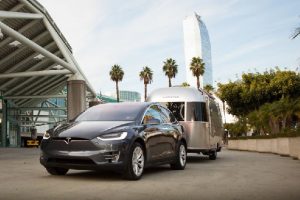 Previously known for being the showcase for electric car launches and ride-and-drives, crossover SUVs are taking more of the attention this year. That doesn’t mean that new electrified vehicles and advanced mobility technologies were forgotten.
Previously known for being the showcase for electric car launches and ride-and-drives, crossover SUVs are taking more of the attention this year. That doesn’t mean that new electrified vehicles and advanced mobility technologies were forgotten.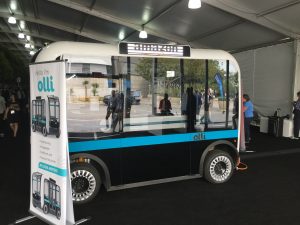 Motors.” That was the first display you’d see when walking in the Technology Pavilion last week. Local Motors specializes in co-creation design projects, such as the 3-D-printed, self-driving Olli minibus that’s currently being tested in pilot programs. It appears to be working on this electric, self-driving minibus project with Amazon, as you can see displayed in the exhibit photo. Designed to transport up to 12 riders, Olli uses IBM Watson’s “Internet of Things” cognitive computing capabilities to learn from data generated from sensors on the vehicle and encourage an interactive transit experience. Phoenix-based Local Motors is also working on a range of designs for 3-D-printed cars. The company recently sold some Olli units in Copenhagen and plans to announce its U.S. debut in next few months. It’s currently being tested on private roads in the Washington, D.C. area. On Wednesday of last week during AutoMobility LA, Olli shuttled Local Motors CEO Jay Rogers to his keynote address.
Motors.” That was the first display you’d see when walking in the Technology Pavilion last week. Local Motors specializes in co-creation design projects, such as the 3-D-printed, self-driving Olli minibus that’s currently being tested in pilot programs. It appears to be working on this electric, self-driving minibus project with Amazon, as you can see displayed in the exhibit photo. Designed to transport up to 12 riders, Olli uses IBM Watson’s “Internet of Things” cognitive computing capabilities to learn from data generated from sensors on the vehicle and encourage an interactive transit experience. Phoenix-based Local Motors is also working on a range of designs for 3-D-printed cars. The company recently sold some Olli units in Copenhagen and plans to announce its U.S. debut in next few months. It’s currently being tested on private roads in the Washington, D.C. area. On Wednesday of last week during AutoMobility LA, Olli shuttled Local Motors CEO Jay Rogers to his keynote address. technology and a combination of aluminum and carbon fiber. The company’s concept was designed to change the way cars are manufactured by using technology that reduces pollution and the amount of materials. Divergent 3D’s Blade printed supercar greeted visitors in the atrium of the LA Convention Center. The company also showed a 3D printed motorcycle, and a sports car frame displayed, as seen in this photo, during the L.A. Auto Show.
technology and a combination of aluminum and carbon fiber. The company’s concept was designed to change the way cars are manufactured by using technology that reduces pollution and the amount of materials. Divergent 3D’s Blade printed supercar greeted visitors in the atrium of the LA Convention Center. The company also showed a 3D printed motorcycle, and a sports car frame displayed, as seen in this photo, during the L.A. Auto Show. Electric launches at LA Auto Show: Along with crossover utility vehicles, plug-in electrified vehicles will see a few North American launches at the LA Auto Show.
Electric launches at LA Auto Show: Along with crossover utility vehicles, plug-in electrified vehicles will see a few North American launches at the LA Auto Show. 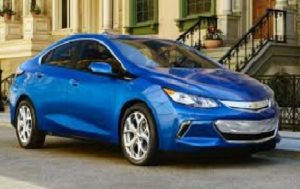 Hybrid and EV sales: Hybrid and plug-in sales
Hybrid and EV sales: Hybrid and plug-in sales  As you probably know by now, the Federal Highway Administration released a map last week showing 55 routes across the U.S. for charging plug-in vehicles and refueling alternative fuel vehicles, with 48 designated charging routes in the new corridor. The Alternative Fuel Corridors covers 35 states and nearly 85,000 miles, according the U.S. Department of Transportation’s FHWA. More miles will be added to the network to accommodate electric, hydrogen, propane autogas, and natural gas vehicles as more alternative fueling and charging stations are built.
As you probably know by now, the Federal Highway Administration released a map last week showing 55 routes across the U.S. for charging plug-in vehicles and refueling alternative fuel vehicles, with 48 designated charging routes in the new corridor. The Alternative Fuel Corridors covers 35 states and nearly 85,000 miles, according the U.S. Department of Transportation’s FHWA. More miles will be added to the network to accommodate electric, hydrogen, propane autogas, and natural gas vehicles as more alternative fueling and charging stations are built. China is facing a challenge similar to the U.S. – how to get car shoppers to buy more clean vehicles and less gas guzzling pollution emitters like large SUVs. While plug-ins, or “new energy vehicles,” have taken off in sales during the past couple of years, China’s regulatory and incentive structure appears to be changing toward a broader definition of clean vehicles. Toyota and a few Chinese automakers and suppliers are asking the government to support plug-less hybrids as another way to reduce tailpipe emissions and dependence on imported oil
China is facing a challenge similar to the U.S. – how to get car shoppers to buy more clean vehicles and less gas guzzling pollution emitters like large SUVs. While plug-ins, or “new energy vehicles,” have taken off in sales during the past couple of years, China’s regulatory and incentive structure appears to be changing toward a broader definition of clean vehicles. Toyota and a few Chinese automakers and suppliers are asking the government to support plug-less hybrids as another way to reduce tailpipe emissions and dependence on imported oil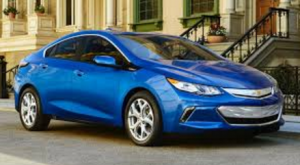 September sales: The
September sales: The 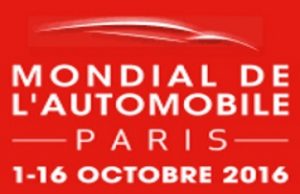 As previewed last week, the Paris Motor Show has gone through a do-over – what was once the hallmark auto show for high-performance luxury and sports supercars (with many of them powered by diesel engines) is now shifting over to electric cars as the stars of the show. Crossover utility vehicles with battery power is another trend noticed by observers.
As previewed last week, the Paris Motor Show has gone through a do-over – what was once the hallmark auto show for high-performance luxury and sports supercars (with many of them powered by diesel engines) is now shifting over to electric cars as the stars of the show. Crossover utility vehicles with battery power is another trend noticed by observers.